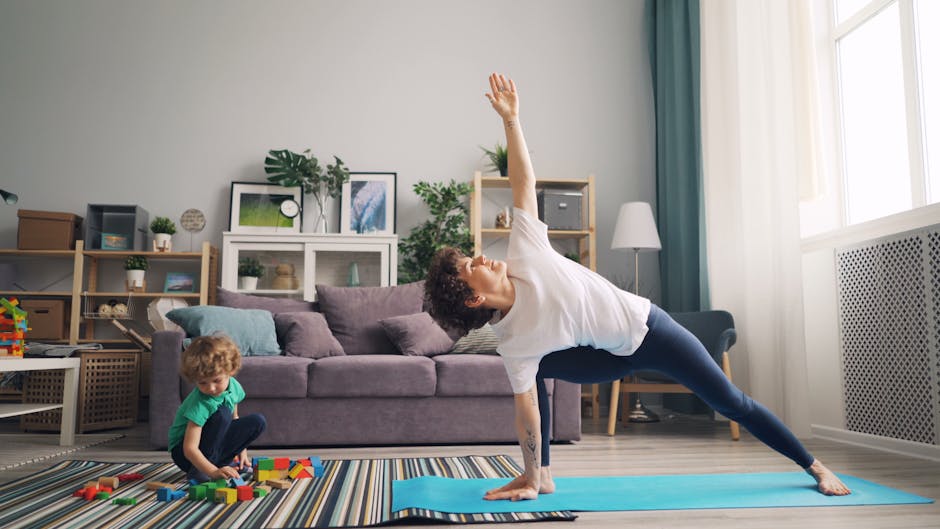A transformative yoga retreat is more than just a vacation—it’s a journey of self-discovery, rejuvenation, and spiritual growth. But what makes a yoga retreat truly transformative? Let’s dive into the essential elements that can turn a simple getaway into a life-changing experience.
Key Takeaways
- The location of a yoga retreat plays a significant role in the overall experience.
- A well-thought-out theme can set the tone and intention for the retreat.
- A balanced daily schedule and nourishing cuisine are crucial for a successful retreat.
- Fostering a sense of community and conducting mindful workshops can enhance the transformative experience.
- Effective marketing and professional guidance are key to attracting and retaining participants.
- Seamless logistics and engaging activities can make the retreat more enjoyable and memorable.
Choosing the Ideal Location for a Yoga Retreat
Factors to Consider in Selecting a Location
Natural beauty and tranquility
The location of a yoga retreat can significantly influence the overall experience. A place surrounded by natural beauty and tranquility can provide the perfect setting for relaxation and introspection.
Accessibility and convenience
While a remote, serene location may sound ideal, it’s also important to consider accessibility and convenience. Participants should be able to reach the retreat location without too much hassle.
Impact of Location on Participants’ Experience
Enhancing relaxation and disconnection
A peaceful and beautiful location can enhance relaxation and help participants disconnect from their daily routines. It can provide a refreshing change of scenery that stimulates the senses and rejuvenates the mind.
Facilitating deeper connection with nature
Being in nature can facilitate a deeper connection with oneself and the environment. It can provide opportunities for outdoor activities like hiking or meditation in nature, which can enrich the retreat experience.

Crafting the Perfect Retreat Theme
Importance of a Thoughtful Theme
Setting the tone and intention
A well-thought-out theme can set the tone and intention for the retreat. It can provide a focus for the activities and practices, helping participants to align their personal goals with the retreat’s objectives.
Aligning activities and practices with the theme
The theme should be integrated into all aspects of the retreat, from yoga sessions to workshops and even meals. This can create a cohesive and immersive experience that resonates with participants.
Steps to Define and Integrate the Theme
Finding inspiration and defining focus
Finding inspiration for the theme can come from various sources, such as a particular yoga philosophy, a season, or even a book. Once the theme is defined, it can serve as a guiding principle for planning the retreat.
Integrating the theme to nurture connection and community
The theme can be integrated into the retreat in various ways to nurture a sense of connection and community among participants. This could include themed group activities, discussions, or even themed decorations.

Designing a Balanced Daily Schedule
Key Components of a Daily Schedule
Time for structured activities
A balanced daily schedule should include time for structured activities, such as yoga sessions, workshops, and group activities. These can provide structure and routine, helping participants to stay focused and engaged.
Free time for personal reflection and relaxation
Equally important is free time for personal reflection and relaxation. Participants should have ample time to rest, explore, or engage in personal practices.
Importance of Flexibility in the Schedule
Allowing participants to listen to their bodies
Flexibility in the schedule is crucial to allow participants to listen to their bodies and adjust their activities accordingly. This can help prevent burnout and ensure a more enjoyable and beneficial experience.
Adapting to group dynamics and feedback
Being adaptable to group dynamics and feedback can also enhance the retreat experience. The schedule should be flexible enough to accommodate changes based on participants’ needs and preferences.

Ensuring Nourishing Cuisine
Role of Food in Enhancing the Retreat Experience
Supporting physical health and energy levels
Food plays a crucial role in supporting participants’ physical health and energy levels. Nutritious and delicious meals can fuel the body for yoga practices and other activities.
Catering to dietary needs and preferences
It’s also important to cater to participants’ dietary needs and preferences. This can include providing vegetarian or vegan options, gluten-free meals, or accommodating specific dietary restrictions.
Planning the Menu
Balancing nutrition and taste
Planning the menu involves balancing nutrition and taste. Meals should be nutritious to support physical health and energy levels, but also delicious to satisfy the palate.
Incorporating local and seasonal ingredients
Incorporating local and seasonal ingredients can enhance the culinary experience. It can also support local communities and contribute to sustainability.

Fostering Connection and Community
Activities to Build Community
Group yoga sessions
Group yoga sessions can foster a sense of community among participants. Practicing yoga together can create a shared experience that brings people closer together.
Shared meals and social gatherings
Shared meals and social gatherings can also contribute to building community. These can provide opportunities for participants to connect, share experiences, and form friendships.
Creating a Welcoming and Inclusive Atmosphere
Importance of openness and respect
Creating a welcoming and inclusive atmosphere is crucial for a transformative yoga retreat. This involves fostering a culture of openness and respect, where everyone feels valued and accepted.
Strategies for encouraging participation and interaction
Strategies for encouraging participation and interaction can include facilitating group discussions, organizing team-building activities, or providing opportunities for participants to share their experiences or skills.

Conducting Mindful Workshops and Practices
Selection of Workshops
Aligning with the retreat theme
The selection of workshops should align with the retreat theme. This can provide a deeper exploration of the theme and enhance the learning experience.
Offering variety to cater to different interests
Offering a variety of workshops can cater to different interests and needs. This could include yoga workshops, meditation sessions, or even creative workshops like painting or writing.
Benefits of Mindful Practices
Deepening yoga practice
Mindful practices can help participants deepen their yoga practice. This can enhance their physical flexibility and strength, as well as their mental and emotional well-being.
Enhancing mental and emotional well-being
Mindful practices like meditation or breathwork can enhance mental and emotional well-being. They can help participants manage stress, cultivate mindfulness, and develop a deeper sense of inner peace.
Implementing Effective Marketing and Promotion Strategies
Identifying the Target Audience
Understanding demographics and preferences
Identifying the target audience involves understanding their demographics and preferences. This can help tailor the retreat to meet their needs and expectations.
Tailoring messages to resonate with potential attendees
Tailoring marketing messages to resonate with potential attendees can increase the effectiveness of promotional efforts. This could involve highlighting the benefits of the retreat, the unique features of the location, or the expertise of the instructors.
Promotion Techniques
Utilizing social media and online platforms
Social media and online platforms can be effective tools for promoting the retreat. They can reach a wide audience and provide opportunities for potential attendees to learn more about the retreat.
Engaging past participants for referrals
Engaging past participants for referrals can also be a powerful promotional strategy. Satisfied participants can provide testimonials or share their experiences, attracting new attendees.

Providing Professional Guidance
Importance of Experienced Instructors
Ensuring safety and proper technique
Experienced instructors are crucial for ensuring safety and proper technique during yoga practices. They can provide guidance and adjustments, enhancing the learning and practice experience.
Enhancing the learning and transformative experience
Instructors can also enhance the learning and transformative experience through their knowledge, skills, and personal qualities. They can inspire and motivate participants, fostering a deeper understanding and appreciation of yoga.
Role of Support Staff
Ensuring smooth operations
Support staff play a crucial role in ensuring smooth operations during the retreat. They can handle logistics, prepare meals, and attend to participants’ needs.
Handling logistics and participant needs
Handling logistics and participant needs efficiently can contribute to a positive retreat experience. This can include managing the schedule, coordinating transportation, or addressing any issues that arise.
Managing Seamless Logistics
Pre-Retreat Planning
Detailed itinerary and scheduling
Pre-retreat planning involves creating a detailed itinerary and schedule. This can help ensure a smooth flow of activities and provide participants with a clear understanding of what to expect.
Transportation and accommodation arrangements
Transportation and accommodation arrangements should be managed efficiently to ensure a comfortable and hassle-free experience for participants.
On-Site Coordination
Handling day-to-day operations
On-site coordination involves handling day-to-day operations, from managing the schedule to ensuring the cleanliness and comfort of the accommodation.
Addressing unforeseen issues promptly
Addressing unforeseen issues promptly and effectively can contribute to a positive retreat experience. This could involve adjusting the schedule due to weather conditions, addressing participants’ concerns, or managing any other issues that arise.
Including Engaging Activities
Types of Activities
Outdoor adventures like hiking or kayaking
Including engaging activities can make the retreat more enjoyable and memorable. Outdoor adventures like hiking or kayaking can provide fun and exciting experiences, while also connecting participants with nature.
Creative workshops like painting or writing
Creative workshops like painting or writing can provide a different kind of engagement, stimulating creativity and self-expression.
Benefits of Engaging Activities
Strengthening the mind-body connection
Engaging activities can strengthen the mind-body connection, enhancing the benefits of yoga and meditation practices.
Providing fun and memorable experiences
They can also provide fun and memorable experiences, making the retreat more enjoyable and enriching.
In conclusion, a transformative yoga retreat involves careful planning and consideration of various elements, from the location and theme to the schedule, cuisine, community, workshops, marketing, professional guidance, logistics, and activities. By paying attention to these elements, you can create a retreat that not only provides a refreshing break from daily life but also fosters personal growth and transformation.
For more insights on yoga retreats, meditation practices, and personal rejuvenation, explore our other articles on creating a personal retreat at home, building a meditation practice for beginners, and Buddhist meditation.
Sources: The Essential Ingredients for Your Yoga Retreat Success, The Essential Guide to Organizing a Successful Yoga Retreat, Crafting the Perfect Retreat Theme: A Guide for Yoga Instructors.
Unfolding Serenity: Your FAQ Guide to the Essential Elements of a Transformative Yoga Retreat
What defines a transformative yoga retreat?
A transformative yoga retreat is designed to offer more than just a series of yoga classes. It’s an immersive experience that combines physical practice with elements of meditation, mindfulness, and sometimes even adventure, aimed at fostering personal growth, healing, and self-discovery. These retreats often take place in serene environments that encourage reflection and connection with nature, providing a break from the hustle and bustle of daily life.
How important is the location for a yoga retreat?
The location is crucial as it sets the stage for transformation. Ideally, a yoga retreat should be situated in a peaceful and beautiful setting that resonates with tranquility and inspiration. Natural surroundings like beaches, mountains, or forests can enhance the experience, facilitating a deeper connection with oneself and the environment. The right location can significantly impact the effectiveness of the retreat by supporting the journey inward and the practice of mindfulness.
What types of yoga practices are typically included?
Most yoga retreats offer a blend of various yoga styles to cater to different levels and interests. Common practices include Vinyasa for its fluid movement, Hatha for its slower pace focusing on alignment and breath, and Yin yoga for deep tissue and fascia release. Additionally, meditation and pranayama (breath work) sessions are often incorporated to complement the physical practice and enhance mental clarity and relaxation.
Can beginners attend a yoga retreat, or is it only for experienced practitioners?
Yoga retreats are generally designed to be inclusive, offering sessions for all levels from beginners to advanced practitioners. Instructors typically provide modifications for poses to accommodate different skill levels. Beginners can benefit immensely from the immersive experience, gaining a deeper understanding and foundation in yoga practices in a supportive environment.
What should I expect in terms of accommodation and meals?
Accommodations can vary widely from luxury villas to eco-friendly cabins, depending on the retreat’s focus and location. Meals are usually included and often feature nutritious, locally sourced, and vegetarian or vegan options to complement the holistic health and wellness aspect of the retreat. Some retreats may also offer dietary accommodations for specific needs.
Are there any additional activities or workshops included?
Many yoga retreats enrich the experience with workshops and activities aimed at personal development, such as journaling, goal setting, and mindfulness practices. Outdoor activities like hiking, paddleboarding, or cultural excursions may also be part of the retreat, offering a chance to explore the surroundings and engage in new experiences.
How can a yoga retreat contribute to personal growth and wellness?
A yoga retreat offers a unique opportunity to step away from daily routines and distractions, allowing for introspection and self-care. The combination of physical practice, mindfulness, and community can foster personal growth, emotional healing, and a sense of well-being. Participants often leave with a renewed perspective, deeper yoga practice, and tools to incorporate mindfulness into their everyday lives.
What should I pack for a yoga retreat?
Packing for a yoga retreat should include comfortable yoga attire, a reusable water bottle, personal yoga mats (though some retreats provide them), and any personal meditation aids like a journal or mala beads. It’s also wise to bring clothing suitable for the retreat’s location and season, along with any personal necessities. Some retreats might suggest specific items to bring, so it’s a good idea to check in advance.



